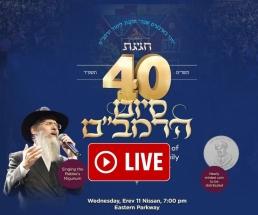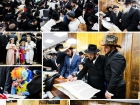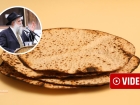On the Set of “The Faithful Shepherd”
Just a few months after Gimmel Tammuz 5754, thousands of children stuck a VHS into their video machines and were taken on an adventure of faith. Beis Moshiach sat down with Mendy Chanin and Shimmy Weinbaum, two of the then-bachurim who took part in this production, and were taken backstage of a camp play that restored hope, faith and meaning to a generation • Full Article
Yisroel Lapidos, Beis Moshiach
“The truth is that we weren’t thinking, because if would have been thinking, we wouldn’t have done it.” This answer, by Mendy Chanin includes all the activities done in the first year following Gimmel Tammuz that aroused the belief of Chassidim in the eternal truth of what the Rebbe said.
However, the truth is that the story did not begin with The Faithful Shepherd, but long before that.
“We started in camps in the United States,” say R’ Mendy Chanin and R’ Shimmy Weinbaum, “where we were counselors and learning directors. The first recording of ‘Oh Rebbe’ that was recorded in 5753, were camp songs of that time, songs that were engraved in the hearts of everyone like ‘Oh Rebbe,’ ‘Where Is the Hand’ and others. They were written in English for various camps and they expressed the feelings of both campers and counselors.
“By the way, at that time, learning material was coordinated for all the camps. Some bachurim prepared the material on the topic that the Rebbe spoke about at that time (whether Mihu Yehudi, shleimus ha’aretz, etc.) and all the camps would take this material and structure all their activities, plays, theme songs, shiurim around it.
“Obviously, during those years, the material had a strong Moshiach emphasis. In the camps of 5752-5753 the focus was on the bitachon in the Rebbe’s prophecy and and prayers for a refuah shleima. That is when the songs that were on the first recording were composed and submitted to the Rebbe. R’ Leibel Groner, who played it for the Rebbe in Beth Israel Hospital, asked us repeatedly for more and more copies for all the doctors and nurses.
UNFAZED BY THE TEST
“Gimmel Tammuz, we were at the height of our work for the camps. We created a series of shiurim for the day camps that have kids who are not frum. For them, we prepared lessons on basics like holidays, a yarmulka, tzitzis, etc. The work was straightforward – you give a bachur a topic and he has to find sources, an interesting story on the subject and connect it to Moshiach. We brought the material to R’ Aharon Herman who is a good writer and he edited the materials and translated them into English.
“On Gimmel Tammuz itself we were fully imbued with the sense that what the Rebbe says is eternal, chai v’kayam, etc. Whether it was dancing ‘Yechi’ for hours, pages of sources with excerpts from sichos of 5711 with the exceptional expressions spoken then, and the atmosphere in general.
“Naturally, the learning material for camp changed immediately. The messages now revolved around emuna and bitachon that the Rebbe is with us and nothing changed.
“As part of those activities, Yochanan Rivkin wrote a play called The Faithful Shepherd. It uses a parable to explain our situation today (see sidebar). The play was very successful (the role of the Chacham was played by YY Jacobson) and was filmed and preserved.
“We weren’t in that camp. We saw the film of the play and we loved the idea. In 5755, we went to learn in Kfar Chabad. We very quickly began doing activities with the children in the Kfar. It is hard to describe the difference between the children of Crown Heights, at that time, and the children in Kfar Chabad. First, their connection with the Rebbe. The children of Crown Heights lived with the Rebbe every second as opposed to the children of Kfar Chabad to whom the Rebbe was a distant figure to whom you have to travel by plane to another country … In addition, the children of Kfar Chabad had no concept of regular organized activities not to mention summer camps.
“We made children’s rallies, a Lag B’Omer parade for the first time in Kfar Chabad, booklets with excerpts from sichos for children, and much more. Every off-Shabbos that we did not go away, we made a huge Shabbos for the kids in Kfar Chabad in the yeshiva. Every month, we translated one song from ‘Oh Rebbe’ and that is how the ‘Oh Rebbe’ tape was created in Hebrew.
“Every bachur did what he could; one wrote a play, one translated a song, one arranged a Chanuka gathering or Purim event, really ‘tut altz vos ir kent.’
“As for the children, they were thrilled. Everything was a chiddush for them. They were ecstatic with whatever we did for them. Once, we brought them rides and they played and had a great time. Our feeling was that we were bringing ‘food’ to a place where, up until then, they were going ‘hungry.’
FILMING THE MOVIE
“Then we remembered about the successful play. We decided to make a movie out of it in Eretz Yisrael. At that time, R’ Motti Gal produced a movie for non-observant people called Massa Bar Mivtza. This gave us a big push to produce the movie and intensify the emuna among the children.
“We took a camera from R’ Yirmiyahu Sudakevitz of Kfar Chabad and began filming together with R’ Yirmi outside of sedarim, based on the script from the camp.
“The filming was very disorganized and it was all very spontaneous and last-minute. We filmed each scene somewhere else. The beach scene was filmed in Yaffo, the prison in Acco, alleyways in Yerushalayim and Tzfat, the ruin in a deserted place between Kfar Chabad and Tel Aviv, and the classroom was actually filmed in Montreal … One day, someone told us that there is a horse near the yeshiva. We ran over, put on our costumes and filmed. There were also more complicated scenes. We filmed the opening to the cave of the Chacham in one place and the interior of the cave somewhere else.
“In general, the conditions were not as developed as they are today, to say the least. We did not have enough people so in some scenes, Mendy was both the videographer as well as the actor. He would set up the camera, press ‘play’ and enter the frame …”
There were also many funny episodes during the filming. One time, says Mendy, I went around Yerushalayim with the white beard of the Chacham. People did not understand what exactly they were seeing and a child asked his mother fearfully, who is that man? I went over to him and whispered as I passed him, “Dovid Ha’Melech.” The child began to shriek, “Hey, Imma! It’s Dovid Ha’Melech!”
Another incident happened when we filmed the house of the Chacham. We found an abandoned ruin and went out one Friday with all the equipment and filmed the scene. Then we hurried to get back to Kfar Chabad. We stood on the road and tried to stop a taxi or hitch a ride but nobody was willing to stop for the weird-looking group with the interesting clothes.
Sunset was approaching and in the end, a taxi stopped that was willing to take us to Kfar Chabad even though we were six people. Mendy, who was dressed up as the Chacham, sat in the front. During the ride, he removed his hat and the astonished driver saw his black hair which contrasted sharply with his white beard. Boruch Hashem, the driver did not get into an accident …
HOW DO YOU WRITE A SCRIPT?
Messages of emuna and bitachon are scattered through every detail of the plot, starting with the words of the Chacham about “Geula for the Jews of the city,” his explanation that “I know and told you that there would be such a calamity here,” then what he says about “the responsibility that you have to do all that you can to bring about the Geula,” and culminating in the belief of the students in what their teacher told them.
It all revolves around the point of the belief that the Rebbe is concealed from us but he is chai v’kayam and will immediately return and redeem us. Even the song that the guard sings in Spanish is a translation of Yechi Adoneinu.
The most memorable scene for me, says Shimmy, is the part where the talmidim argue about the prophecy of the Chacham. I felt how this scene really reflected our current situation, the Chacham disappears, a decree of exile hovers over the Jews, there is no prophet to tell them the future, the talmidim are so alone and most importantly, they need to grasp every shred of hope and every spark of emuna in order to bring about the hisgalus.
As far as the beginning and end of the film that is obvious; the dialogue between the teacher (R’ Noam Wagner) and the talmid (Yehuda Ceitlin). In those scenes we simply said things as they were and as we felt at the time. We don’t see the Rebbe and it’s very hard but we are sure that the Rebbe is chai v’kayam, is with us, and will immediately be revealed and redeem us.
What we wanted to show the children, and this was communicated and internalized, is that the Rebbe promised and the Rebbe will keep his promise. There is nothing to challenge or question about that. Even if you don’t see and don’t hear, the emuna in what the Rebbe said is stronger than anything and in the end, it will bring about the hisgalus.
SURPRISING SUCCESS
At first, we produced 1000 copies and sold each one for $20. We couldn’t believe how many were sold and were viewed. By now, thousands of copies of the movie have been distributed in the United States. Says Mendy, when I’m out on the street, people point me out to their kids, “There’s the Chacham…” Someone even dressed up like the Chacham for Purim and brought me mishloach manos! I think that all Lubavitcher children (at least the Americans) have seen the movie at least once.
Mendy’s grandfather, R’ Itzke Gansbourg, saw the movie and was very excited by it. He took a copy, added Hebrew subtitles and gave it out in Eretz Yisrael.
They conclude: The Rebbe’s prophecy did not change. The same emuna and the same passion we had then, needs to burn in us now too and motivate us to carry out such activities.
SHOUT-OUT TO THE CAMPS
Mendy and Shimmy call upon all bachurim who run camps to put work into conveying messages by using technology, since we know that all the technological advances in the world were created solely “l’havi l’Yemos Ha’Moshiach,” to spread the Besuras Ha’Geula to the world. The whole idea of a video camera is to be used to more powerfully convey spiritual-Jewish content.
Shimmy: Back in the day, R’ Zalman Chanin bought a fax machine with which to send sichos of the Rebbe and he reported about this to the Rebbe. The Rebbe’s answer was: Why first now? This should have been done a while ago; that is why it was created. A fax machine was created to send sichos of the Rebbe to the world. Cameras and movies were meant to convey a message of the Rebbe (and not for nonsense or inappropriate things). We really need to produce more movies like this and impact the viewers. The children will learn from it and those involved in the work will too.
This will create competition between the camps in the U.S. and Eretz Yisrael of “who made the best movie.” Each camp will produce a movie, obviously well thought out and with substance, and submit it in a contest. I believe that when there is competition between the camps, it will generate higher quality movies and the beneficiaries will be the children themselves, in terms of the numbers of quality films and also the messages that affect them deeply.
*
THE FAITHFUL SHEPHERD
The Faithful Shepherd tells the story of a Chassidishe boy who lives in Crown Heights, whose spiritual state deteriorated after Gimmel Tammuz. He stopped listening in class, came late, etc.
He explained to his teacher that before Gimmel Tammuz, what motivated him was knowing that the Rebbe received reports about him. Knowing that he gave the Rebbe much nachas spurred him on in his Chassidishe behavior. In order to get him to understand that even now, his actions are significant, the teacher explains that it is during the final moments of galus that we need to be strong and increase in Torah and mitzvos, and a small deed by a young boy can tip the scales and bring the Geula to the world.
In order to illustrate the power that the boy has, the teacher tells him a parable about a Jewish community whose leader is called “Chacham Moshe.” In the kingdom where this community was, there were two anti-Semitic ministers who were jealous of the Jews’ financial success and the friendly attitude the king had toward them. They decided to put an end to this and together plotted against the Chacham whom the king loved.
Late at night, they went to the king’s treasury, gave the guard strong liquor to drink so he became unconscious and entered the cellar where all the kingdom’s treasures were kept. The ministers put the treasures in their sacks and left and when they went to where the Jews lived, they threw some of the treasure into the home of the Chacham and took the rest to their home.
When the break-in and robbery were discovered, the “loyal” ministers of the king conducted a search in the home of the Chacham and reported to the king that the stolen treasure was in his house, but the Chacham left town. The king was angry over the Chacham’s ingratitude and immediately had announcements made in the streets that if the community did not hand over the Chacham within six days to be killed, all the Jews would be expelled from the country and the money confiscated.
When the terrible news was heard by the students of the Chacham, they screamed and wailed. As they sat and cried, they remembered the class the Chacham had given the day before, in the beis medrash, in which he suddenly got up, closed the sefer, and said, “Listen my dear students. We are on the threshold of the Geula and Moshiach is coming already. What remains is for us to start living as though the Geula is already here, to have unity among the students, to always be happy as we will be in the Geula until we will be able to point and say, here is Moshiach!
“Now, dear students, I must leave for a short while but during this time, continue working and don’t forget that you need to bring Moshiach!”
Three of his most devoted students, Pinchas, Emanuel and Yosef, decided to go and search for the Chacham and warn him not to return to the city. On their way out of the city, they met the Chacham and they told him of the libel against him and the terrible danger threatening the community and him in particular.
The Chacham went into a deep state of deveikus and then said, “My dear students, you are facing a very difficult period but you need to deal with this test yourselves; only you can bring about a successful conclusion. I will always be with you in your difficult times but it’s in your hands!” The Chacham parted from his students and blessed them and remained alone in a hidden cave. The students tried in various ways to reveal the ministers’ sinister plot, as a result of which, Yosef was imprisoned.
The situation grew more complicated and the students began to despair. Because of the serious situation, the students immediately went in the direction of their leader’s hiding place but upon arriving at the cave they discovered that the Chacham was not there. They burst into tears and sat on the floor of the cave feeling helpless. They they remembered their teacher’s final words, “I know that it’s hard for you. I will always be with you and I will give you all the kochos, but the matter is in your hands!”
The students returned to the city, fortified by his words. They could not despair. The responsibility was theirs. On their way to the city, they passed by the prison where their friend was imprisoned. They bribed the jailer to give their friend his tefillin. When the jailer saw the Jewish prisoner wearing tefillin he suddenly remembered his childhood, and how his father and grandfather put on tefillin. He got into a conversation with the student who told him about the plot of the ministers.
Hearing this, the jailer immediately reported it to the king’s palace and an investigation was conducted and most of the stolen treasure was found in the ministers’ house. The ministers were hung and the Jews were saved and the decree of the Chacham’s execution was canceled. The students rejoiced and they understood how important it is to strengthen belief in the words of the Chacham that the Geula will happen immediately and we will see him again!
*
The magazine can be obtained in stores around Crown Heights. To purchase a subscription, please go to: bmoshiach.org
400
Join ChabadInfo's News Roundup and alerts for the HOTTEST Chabad news and updates!











































Thank you for sharing!